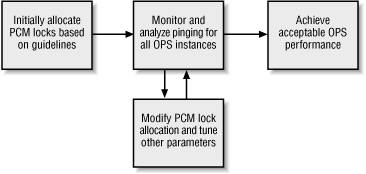Monitoring and tuning are important activities in any Oracle server environment, and all of the tuning activities required in a standalone Oracle server environment also are applicable in Oracle Parallel Server environment. With Oracle Parallel Server, you’ll need to perform additional tuning activities to reduce PCM lock contention and pinging. OPS monitoring and tuning activities have added significance because OPS performance can degrade to a point at which it’s worse than that of a single-instance server if PCM locks are not properly tuned. In this chapter we focus on the essentials of tuning and monitoring for OPS, covering the following topics:
Monitoring PCM lock activity
Monitoring overall system statistics
Monitoring Integrated Distributed Lock Manager statistics
Tip
Section 10.6 describes an Oracle tool that automates some of the monitoring operations described in this chapter. You must have a license for this software.
One of the major goals of OPS tuning is to properly allocate PCM locks in order to reduce pinging. When you first create an OPS environment, you typically use guidelines such as those provided in Chapter 8, to help make your initial PCM lock allocation. After your OPS instances are started, you can use dynamic performance views to monitor lock activity, pinging, and other OPS-related statistics. You should analyze these statistics to identify the particular files, objects, and blocks that are pinged the most. Then, modify your PCM lock allocation and restructure tablespaces as necessary in order to reduce the amount of pinging that occurs.
Tuning is an iterative activity, and you may need to repeat the monitoring and adjustment process several times before you are satisfied with your OPS response times. After you’ve achieved an acceptable performance level, further tuning may not be required even if you do observe some pinging, unless you expect a large increase in database size or in the number of transactions. Figure 10.1 illustrates the OPS tuning process.

